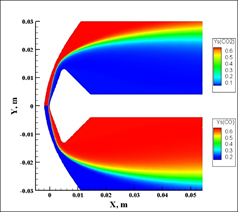Prediction of aerothermal environment around atmospheric entry vehicles with sophisticated numerical tools
JAXA Supercomputer System Annual Report April 2016-March 2017
Report Number: R16E0008
- Responsible Representative: Shigeru Hamamoto(Aeronautical Technology Directorate, Aerodynamics Research Unit)
- Contact Information: Toshiyuki Suzuki(suzuki.toshiyuki@jaxa.jp)
- Members: Adrien Lemal, Toshiyuki Suzuki, Takashi Ozawa, Toru Yamada, Yuuto Higuchi
- Subject Category: Basic Research(Numerical analysis,Modeling,CFD,other )
Abstract
In this study, we try to enhance the physical model for high temperature gas and numerical simulation method to accurately predict the heating and aerodynamic characteristics at the hypersonic atmospheric entry. We aim to realize high fidelity simulation tool by demonstrating the accuracy of the prediction by comparing experimental data and simulation results with newly proposed model and method.
Goal
In this study, we aim to accurately predict aerodynamic heating and aerodynamic force exerced on the planetary exploration capsule during the atmospheric entry (hereinafter referred to as aerothermodynamic characteristics). We also aim to develop a thermochemical model and numerical analysis method to improve the prediction and accuracy of aerothermodynamic characteristics.
Objective
The goal of this study is to accurately predict the following parameters during the atmospheric entry flight:
- capsule wall heat flux and aerothermodynamic characteristics under hypersonic regime
- aerodynamic characteristics atsubsonic, transonic and supersonic regimes near parachute deployment point
References and Links
N/A
Use of the Supercomputer
In order to evaluate uncertainties in nonequilibrium thermochemical model and freestream condition,supercomputer was used to perform a large number of CFD runs by changing physical models and flow conditions.
Necessity of the Supercomputer
In order to accurately evaluate the amount of aerodynamic heating during a hypersonic atmospheric entry at a high angle-of-attack by lifting entry, it is necessary to perform a three-dimensional flow analysis along the entry trajectory.supercomputers are indispensable to carry out a large number of three-dimensional flow simulations in a short time period and to quickly respond to requests such as reevaluation due to changes in trajectory and capsule shape. In this study, Large Eddy Simulation (LES) is utilized to accurately solve the turbulent flow field around the capsule in the Mach number range below the supersonic speed near the parachute deployment point. Three-dimensional unsteady turbulent simulation by LES is extremely computationally expensive, and therefore, it is indispensable to use supercomputers to carry out a large number of simulation cases necessary for capsule design.
Achievements of the Year
We successfully completed the following tasks:
- development of new transport model to address viscosity, conductivity and diffusion for carboneous mixtures,
- development of nonequilibrium chemical model for air plasmas,
- implementation of a spectral database for CO2 infrared radiation at high temperatures.
Specifically, the new transport model is more accurate and cost-effective than the models traditionally used in the community. The nonequilibrium air plasma model was shown tosupercede the performances of the model developed at NASA Ames for conditions representative of HTV-R and Hayabusa 2 Earth reentry. The new CO2 spectral database was assessed for conditions of thermodynamic equilibrium representative of missions currently entertained by JAXA to explore Mars. The new database yields excellent agreement with experimental data from heated cells, micro-wave plasma torches and shock tube radiation measurements for temperatures up to 5000K. The new database was shown to provide better results than the traditional databases HITRAN, HITEMP.

Fig.1:Computation of the flowfield around a small scale capsule model. Mass fraction fields of CO2(upper) and CO (lower)

Fig.2:Characterization of the flow inside JAXA hyper-velocity expansion tube (HVET) facility. Time evolution (top to bottom) of temperature and pressure fields in HVET.
Publications
Peer-reviewed articles
1) Lemal et al., Simulations of CO2 nonequilibrium radiation, in preparation for Journal of Thermophysics and Heat Transfer.
2) Lemal et al., Influence of CO2 vibration models on a Mars entry flow field, in preparation for Journal of Thermophysics and Heat Transfer.
3) Lemal et al., Influence of CO2 thermodynamic model on radiative heating, in preparation for Journal of Thermophysics and Heat Transfer.
4) Lemal et al., Calculation of post shock VUV radiance for high speed Earth entry,submitted to Transactions of the Japan Society for Aeronautical and Space Sciences.
5) Yamada et al., Numerical Simulation of Flow Conditions Generated by Hyper Velocity Expansion Tube,submitted to Transactions of the Japan Society for Aeronautical and Space Sciences.
Non peer-reviewed articles
1) Higuchi et al., Physico-Chemical Parameters Governing the Convective and Radiative Heating from a CO2-based mixture, AIAA 2017-1368, 2017.
Computational Information
- Parallelization Methods: Hybrid Parallelization
- Process Parallelization Methods: MPI
- Thread Parallelization Methods: OpenMP,Automatic Parallelization
- Number of Processes: 16-208
- Number of Threads per Process: 4-32
- Number of Nodes Used: 16-50
- Elapsed Time per Case (Hours): 1-168
- Number of Cases: 200
Resources Used
Total Amount of Virtual Cost(Yen): 7,287,704
Breakdown List by Resources
| System Name | Amount of Core Time(core x hours) | Virtual Cost(Yen) |
|---|---|---|
| SORA-MA | 501,028.04 | 791,433 |
| SORA-PP | 740,570.28 | 6,322,989 |
| SORA-LM | 0.00 | 0 |
| SORA-TPP | 0.00 | 0 |
| File System Name | Storage assigned(GiB) | Virtual Cost(Yen) |
|---|---|---|
| /home | 505.45 | 4,767 |
| /data | 10,051.73 | 94,818 |
| /ltmp | 7,812.50 | 73,695 |
| Archiving System Name | Storage used(TiB) | Virtual Cost(Yen) |
|---|---|---|
| J-SPACE | 0.00 | 0 |
Note: Virtual Cost=amount of cost, using the unit price list of JAXA Facility Utilization program(2016)
JAXA Supercomputer System Annual Report April 2016-March 2017


